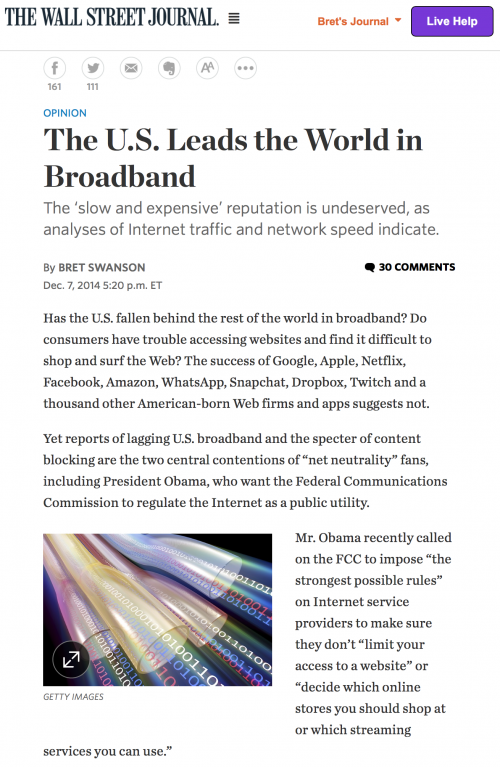See our Wall Street Journal op-ed from December 8, which summarizes our new research on Internet traffic and argues for a continued policy of regulatory humility for the digital economy.
 Continue reading here. Or read the text below the fold . . .
Continue reading here. Or read the text below the fold . . .
Dec. 7, 2014 5:20 p.m. ET
Has the U.S. fallen behind the rest of the world in broadband? Do consumers have trouble accessing websites and find it difficult to shop and surf the Web? The success of Google, Apple, Netflix, Facebook, Amazon, WhatsApp, Snapchat, Dropbox, Twitch and a thousand other American-born Web firms and apps suggests not.
Yet reports of lagging U.S. broadband and the specter of content blocking are the two central contentions of “net neutrality” fans, including President Obama, who want the Federal Communications Commission to regulate the Internet as a public utility.
Mr. Obama recently called on the FCC to impose “the strongest possible rules” on Internet service providers to make sure they don’t “limit your access to a website” or “decide which online stores you should shop at or which streaming services you can use.”
Neither of these rationales for regulatory intervention is true, however, and there’s a simple way to show it. An international comparison of Internet traffic can tell us about the quality of broadband networks and the vibrancy and openness of content markets. Traffic represents all the bits flowing over our networks—email, websites, texts, chats, photos, digital books and movies, video clips, social feeds, searches, transactions, cloud interactions, phone and video calls, interactive maps and apps, software downloads, and much more.
If U.S. broadband were slow, expensive and not widely deployed, one might expect other nations, who supposedly enjoy better broadband, to generate more Internet traffic. But as my new study for the American Enterprise Institute shows, the reverse is true.
To compare nations, I used Internet traffic estimates from the June 2014 edition of the widely cited Cisco Visual Networking Index, population data from the July 2014 update of the Central Intelligence Agency’s World Factbook, and Internet user data from Internet Live Stats, which compiles its estimates using data from the International Telecommunication Union and national and regional authorities.
What I found was that at 18.6 exabytes (18.6 billion gigabytes) a month, the U.S. generates far more traffic per capita and per Internet user than any other major nation save South Korea, which is a vertical metropolis and thus easy to wire with fiber optics. U.S. traffic per capita is 2.1 times that of Japan and 2.7 times that of Western Europe. Several years ago, U.S. and Canadian traffic measures were similar, but today the U.S. has raced ahead by 25%.
The U.S. lead is similar in traffic per Internet user, which tends to reflect how intensely people use broadband and mobile connections. The U.S. outdoes its closest European rival, the U.K., by 57%. The U.S. outdoes all of Western Europe—the best comparison in terms of geography, population and economic development—by a factor of 2.5.
Studies that show U.S. broadband is slow and expensive generally don’t observe actual consumer behavior and thus don’t measure true value. This type of unsystematic analysis is widespread and misleading. A recent New America Foundation report claiming that open access regulations in foreign nations boost broadband capacity and reduce prices, for example, led to a credulous New York Times story headlined “Why the U.S. Internet Has Fallen Behind in Speed and Affordability.”
Actual speed measures from Akamai Technologies support the conclusions of my study: Wired and wireless broadband networks in the U.S. are among the world’s fastest, most widely deployed and heavily used. A detailed new study of broadband in the G-7 nations by my AEI colleague, Richard Bennett, confirms these findings.
The huge U.S. traffic advantage also undermines the case that Americans can’t surf or shop where they like. America’s online content, app and e-commerce markets are the largest and most sophisticated in the world.
A forthcoming study by Michael Mandel and Diana Carew of the Progressive Policy Institute finds that since 2007 U.S. per capita consumption of digital goods rose 48%. Americans upload 100 hours of video to YouTube every minute, and YouTube streams six billion hours of video a month. Netflix streams more than 6.5 billion hours of video per quarter, mostly in the U.S. And in the past year, Amazon sold $85 billion in merchandise, digital content and cloud services.
The U.S., with 4% of the world’s population, has 10% of its Internet users, 25% of its broadband investment and 32% of its consumer Internet traffic. The U.S. policy of Internet freedom has worked. Why does Washington want to intervene in a thriving market?
Mr. Swanson, a visiting fellow at the American Enterprise Institute, is president of Entropy Economics LLC, which advises investors and broadband firms.

